Mirella Sichirollo Patzer's Blog, page 21
September 19, 2014
Hoyden of the Week - Treadmill Workout
Published on September 19, 2014 20:00
September 16, 2014
Read the First Chapter - The Novice by Mirella Sichirollo Patzer
The Novice A young woman on the verge of taking her vows to become a nun.A desperate flight from a murderous massacre.One honorable man comes to her rescue.Another becomes her nemesis and captor.And a life and death search to reunite with her one true love.

Chapter One Village of GaetaNorth of NaplesA.D. 915
THE MASSACRE CAUGHT the villagers of Gaeta by surprise. In the convent of Santa Maria delle Vergine, the first shrieks of the Saracen raiders as they raced down the hillsides and into the outskirts of the village had forced the small group of nuns from their beds. Some rushed to the chapel to face the enemy. The others fled terrorized into the summer night. They were the lucky ones. That desperate flight would save their lives. Protected by the hood of her mantle, Sara, a novice, the convent’s only inhabitant who had not yet taken her vows, stood among the sisters clustered together on a hill next to a grove of trees. She shivered against the fading night’s breeze. A full moon and the first rays of dawn shed a scarce light over the valley below. She gazed down at the village of Gaeta—a handful of buildings and homes, a church, and their convent—a sprawling mass of land surrounded on three sides by the sea. An eerie mist hung above it. The desolate tolling of the church bell suddenly rose on the wind. Sara watched in horror as Saracen warriors galloped through the village bellowing their battle cries. A knot of terror jammed in her chest when she saw them enter the convent. She held up a hand, a plea for the women to listen. The church bell suddenly ceased ringing. Screams, shrieks, and moans leapt out of the silence like sparks from a fire. Stunned, Sara could not tear her gaze away. Saracen marauders attacked homes, broke down doors and windows, and dragged villagers and nuns outside to meet their demise. The world was truly desolate, without redemption. The villagers were people she knew, whom she had toiled with and served. There had been no time to warn or save anyone. To each his own. The Saracens were bent at slaughter. A group of villagers had barricaded themselves inside the church. The attackers set fire to the building and waited for them to flee the smoke and flames. Then the bloodthirsty murderers, wielding axes and swords, struck them down. For years, these Saracen enemies had burned towns and hamlets, churches and orchards, pastures and vineyards. The hatred the Saracens bore for the Neapolitan people had resulted in battles that had raged for decades. The reason for the hatred, however, had long faded from everyone’s minds. Sara had never imagined anything like this before – the massacre of an entire village! Cold stark horror gripped her. Gaeta's rude houses were scattered over a wide area. Even if most of the villagers had not been surprised in their beds, they had little chance to help one another. The Saracens slew with merciless brutality, torching structures at random. Sara had heard stories of impaled captives, of fingernails pulled out and limbs hacked off, even decapitations or of people roasted alive at the stake. All she and the nuns could do was watch in horror. The women were unable to tear their gazes from the death striking those who had not been fortunate enough to escape. Some of the sisters fell to their knees to pray and weep. One fainted and lay huddled against a tree trunk. When Sara had heard the first screams, she pleaded for the nuns to flee. Only a few of the women had heeded her advice. The abbess and the most devout chose to lock themselves in the convent’s small chapel to pray and await martyrdom by arrow or spear or axe. Sara and the nuns knelt stunned with fright on the crest of the wind-swept hill watching what might have been their doom. She could not blot out the unfettered visions of the massacre from her mind, the rape, the death. Convent and chapel belonged to them no more. A crimson glow rose above the outline of the village. A long flame soared into the sky like a red tower. Sister Gilda gripped Sara’s hand. A ring of fire encircled the chapel’s belfry and smoke ascended into the night. Flames now fully engulfed the buildings. Sara mourned the men, women, and children who had fallen victim to the Saracen’s brutality. She turned away from the mayhem, the rapes, the eviscerations, the killing of babies. Gaeta was no more. She whispered a prayer of gratitude for having escaped. Now, it was up to her to lead these women to safety. Afterwards, she would leave religious life and its severe practices forever. A burning need to put distance between them and the Saracen savages was foremost in her thoughts. She shoved back her hood. Her unbound chestnut hair tumbled down in a wind-ruffled surge upon her shoulders as she turned to face the women. She advanced to speak to the eldest, Sister Gilda, who knelt and watched the burning mission with a stupefied gaze. “Are you going to cower here all night?” Sara’s words lashed out like a scourge. “We must go! Now!” All the nuns turned to stare at her, wide-eyed. “Shame on you!” admonished Sister Gilda, her thin wrinkled face white against the darkness. “Down on your knees, brat! Pray for those who are dying!” Sara let out a brusque laugh. The reprimands of an entire year festered inside her like rotten, bitter herbs. “There is nothing we can do for the dead and dying. We must run for our lives, find help and shelter, otherwise, we will be the Saracen’s next victims. We must live!” “May the Mother of Mercy thaw your arrogant heart and chastise you for your sins,” Sister Gilda retorted. “For a novice, you speak as if you are rotten to the very core of your heart.” “Just because I am not yet a nun, does not mean that my heart doesn’t grieve as passionately as yours, Sister Gilda. The entire village is burning. Stay and scold until dawn if you wish. Stand here and rebuke the murderous Saracens as they ride up this hill to butcher you. I am certain they will give such old beauty as yours short-shrift.” The sinewy nun offered no response. With harsh words, Sara had defeated her many times before. Sister Gilda knew well the value in biting her tongue. Several of the other women rose and flocked around Sara, whining with terror. Their faith, although reverent, failed them in this time of desperation. It would not help guide them to a safe path. They stood trembling in the wilderness, too close to the brutal band of Saracens. There was no safe refuge nearby. Flight in any direction would be dangerous. Sara sensed the night’s horror had unnerved the women. The unknown oppressed them. “It is still dark,” said one, the panic in her voice undisguised. “What will we do?” “Sister Gilda will pray for us,” Sara mocked. “Sara, please help us, you are the wisest among us!” pleaded another. “Then we cannot stand around sniveling,” Sara responded. “The sun will rise soon. I intend to go to the town of Caserta. It is further inland and will be safer.” “But the woods are dreadful during the day as well as in the night,” said one of the younger nuns with wide, dark eyes. Sara took the girl’s hand. “But kinder than the Saracens. Come with me. I will take care of you.” Even as she spoke, she could see a line of torches move away from the village and weave its way up the long slope towards the jagged thicket of trees where Sara stood with the nuns. “Look yonder.” Sara pointed down into Gaeta and the slowly approaching line of torches. “Let Sister Gilda wait and pray until the bearers of those torches arrive. I am fleeing.” An instant clamor arose among the nuns. When courage and resourcefulness were needed most, danger now rendered them helpless. The torches moved side-to-side, ascending the hill as though the Saracen warriors who carried them were doubling right and left, following a jagged trail in the dark like hounds casting about for a scent. It would not be long before the Saracens reached them. The sight was ominous, and renewed their panic. “Sara, please help us!” one of the nuns cried out. They gathered around her, befuddled. Even Sister Gilda lost her appetite for martyrdom and became human once more. They were hungry for a leader and Sara stood among them confident, fearless. She looked toward the east, where a white glow above the treetops told her the sun was rising. “See the dawn?” Sara said. “We will have light soon. There is a path over the hill that heads east and then south. I will take that path. Whoever wishes may follow.” “We will come with you, Sara,” one of the others answered. The five women collected themselves and stood close together. Much to Sara’s surprise, the first one to move was Sister Gilda, who had been in charge of the convent’s linens, and then Sister Maralda, their stout cook. Sisters Flora and Emma, the twins, and Sister Inga followed behind them. They stumbled and faltered, clutching one another. Despite their fear, they made clumsy, but fast progress. Sara led the way through the fading darkness. Soon, they came upon a path at the edge of a wood. They followed it until thickets fully surrounded them. Twisting branches formed a canopy above, and the morning sky became nearly indiscernible between the leaves. To Sara, the forest seemed like a grotto that diminished into a fathomless gloom leading nowhere. Nevertheless, if not for the path’s comfort that promised to lead them to safety, they would have been helpless. Their state of affairs was heartbreaking. As brides of Christ, they had dedicated their lives to peace and lived by a daily regimen of teaching children, chants, charity, and prayers, but even the walls of a convent could not protect them against the vile Saracens who burned homes, martyred children, and sacked and fired entire towns. The failure of their faith to protect them, taunted Sara with every step. Their abbess had often said that the world, for all its apathy and wickedness, deserved to meet the bane of war. Those words, it seemed, had returned to haunt her, bringing about the good woman’s own death. As they trudged through the early morning mist, the sisters grumbled about the sad state of their duchy. It would have been natural for them to cry out for vengeance, to let their resentment soar against those in power who had failed them, but their faith kept them silent. Sara walked in front, listening to their comments with a touch of contempt. “You are very astute, all of you,” she said over her shoulder. “You talk of raids and massacres as though the whole land has been devastated. True, the Saracens have burned defenseless places and stormed towns, but Gaeta is only a tiny village in the duchy of Naples. You must trust that the duke’s soldiers will protect us from these savages.” Sister Gilda glanced heavenward. “I pray that God lets it be so!” “One great man is all that is needed to lead our armies against these heathens,” Sara added. “Perhaps you will find him.” Derision laced Sister Gilda’s words. “Not I. The danger posed by the Saracens will soon bring forth a leader,” Sara responded, ignoring Sister Gilda’s curtness. “Whenever an enemy exists, a hero is certain to come forward. We will find our champion before long, wait and see.” “I wish I could find something to eat,” whined the plump Sister Maralda. As a cook, she always worried about the next meal. “Perhaps Sister Gilda will pray for some provisions,” Sara said. “Bread and water perhaps?” “Bread!” said Sister Maralda. “Did someone speak of bread?” Sara patted her belly. “I have a small loaf hidden under my habit.” Sister Maralda sighed. “Oh, Sara, I would chant a day’s worth of psalms for one morsel of that loaf.” “Chant away, Sister Maralda,” Sara responded. “Begin with Psalm seventy-eight. I believe it is one of the longest.” “Do not tease a hungry sufferer,” Sister Maralda admonished. “The psalms, Sister Maralda, or not a crumb,” Sara said. “Keep it for yourself, you mocciosa viziata, you spoiled brat,” Sister Maralda retorted. “I can go without.” “We will share it, all of us, very soon, unless Sister Maralda wants to eat the entire loaf by herself,” Sara said. In the growing light, Sara kept the women on their path. At times, it led them into patches of open ground, parts of which were covered with brush, while others teemed with bracken and bushes. She had never seen such faint-hearted women as these nuns. If a twig snapped, they clustered together. They mistook an owl's hoot for a Saracen battle cry. A hawk’s trill made them believe someone trailed them. Their sharpest reaction, however, came when they stumbled upon a grazing herd of deer. The sudden bolt and clatter of hooves as the creatures bounded away stirred panic among them. It took some time before Sara could calm them down and urge them to keep walking. She knew it would be many months before the fear of the ordeal they had witnessed would fade from their minds. As the morning dragged on, fatigue slowed them down. They were as frail as ailing children were. Religious life had done little to strengthen their bodies, but had done much to distort their minds. She had no choice but to be strong and unrelenting. The women looked to her for strength and direction. She must get them to safety. Without her to lead them, they would be doomed. She put this knowledge to effect, and held it like a whip over their timidity. As they went, she found ample possibilities to use her cunning. When they pleaded for her to stop so they could rest, she warned she would continue without them. The threat forced them all to plod after her. When they griped, she told tales of Saracen cruelty and lust, and made the fear in their hearts throb more than their weary feet. With these ruses, she kept them moving, knowing that the greatest kindness was heartlessness, and that to indulge them was nothing more than misguided pity. Finally, regardless of the Saracen threat, the exhausted nuns refused to go any farther. Judging by the height of the sun, it was mid-morning. The woods thinned, and they gazed upon a serene valley. A huge oak tree grew nearby. Petulant and complaining, Sister Maralda crept under its boughs, muttering, and committing Sara’s soul to Purgatory. The rest declared they would rather die than take another step. Like the others, Sara’s body soon succumbed to fatigue. Any additional urging on her part to keep the women moving was futile. Bunched together beneath the branches, they soon fell into a weary slumber. She conceded and lay herself down to sleep under the shelter of the tree. Before sleep could overtake her, Sara studied the sleeping women and the world around her. Somewhere in its vastness lay her secret destiny. Her quest for it would be unrelenting. She was determined to live life to its fullest and revel in the glories of joy and love, security and freedom. One day, she decided, she would experience it all. First, however, she must bring them to safety. Then her life would truly begin.Click this link to purchase on Amazon
or click the the icon below










Chapter One Village of GaetaNorth of NaplesA.D. 915
THE MASSACRE CAUGHT the villagers of Gaeta by surprise. In the convent of Santa Maria delle Vergine, the first shrieks of the Saracen raiders as they raced down the hillsides and into the outskirts of the village had forced the small group of nuns from their beds. Some rushed to the chapel to face the enemy. The others fled terrorized into the summer night. They were the lucky ones. That desperate flight would save their lives. Protected by the hood of her mantle, Sara, a novice, the convent’s only inhabitant who had not yet taken her vows, stood among the sisters clustered together on a hill next to a grove of trees. She shivered against the fading night’s breeze. A full moon and the first rays of dawn shed a scarce light over the valley below. She gazed down at the village of Gaeta—a handful of buildings and homes, a church, and their convent—a sprawling mass of land surrounded on three sides by the sea. An eerie mist hung above it. The desolate tolling of the church bell suddenly rose on the wind. Sara watched in horror as Saracen warriors galloped through the village bellowing their battle cries. A knot of terror jammed in her chest when she saw them enter the convent. She held up a hand, a plea for the women to listen. The church bell suddenly ceased ringing. Screams, shrieks, and moans leapt out of the silence like sparks from a fire. Stunned, Sara could not tear her gaze away. Saracen marauders attacked homes, broke down doors and windows, and dragged villagers and nuns outside to meet their demise. The world was truly desolate, without redemption. The villagers were people she knew, whom she had toiled with and served. There had been no time to warn or save anyone. To each his own. The Saracens were bent at slaughter. A group of villagers had barricaded themselves inside the church. The attackers set fire to the building and waited for them to flee the smoke and flames. Then the bloodthirsty murderers, wielding axes and swords, struck them down. For years, these Saracen enemies had burned towns and hamlets, churches and orchards, pastures and vineyards. The hatred the Saracens bore for the Neapolitan people had resulted in battles that had raged for decades. The reason for the hatred, however, had long faded from everyone’s minds. Sara had never imagined anything like this before – the massacre of an entire village! Cold stark horror gripped her. Gaeta's rude houses were scattered over a wide area. Even if most of the villagers had not been surprised in their beds, they had little chance to help one another. The Saracens slew with merciless brutality, torching structures at random. Sara had heard stories of impaled captives, of fingernails pulled out and limbs hacked off, even decapitations or of people roasted alive at the stake. All she and the nuns could do was watch in horror. The women were unable to tear their gazes from the death striking those who had not been fortunate enough to escape. Some of the sisters fell to their knees to pray and weep. One fainted and lay huddled against a tree trunk. When Sara had heard the first screams, she pleaded for the nuns to flee. Only a few of the women had heeded her advice. The abbess and the most devout chose to lock themselves in the convent’s small chapel to pray and await martyrdom by arrow or spear or axe. Sara and the nuns knelt stunned with fright on the crest of the wind-swept hill watching what might have been their doom. She could not blot out the unfettered visions of the massacre from her mind, the rape, the death. Convent and chapel belonged to them no more. A crimson glow rose above the outline of the village. A long flame soared into the sky like a red tower. Sister Gilda gripped Sara’s hand. A ring of fire encircled the chapel’s belfry and smoke ascended into the night. Flames now fully engulfed the buildings. Sara mourned the men, women, and children who had fallen victim to the Saracen’s brutality. She turned away from the mayhem, the rapes, the eviscerations, the killing of babies. Gaeta was no more. She whispered a prayer of gratitude for having escaped. Now, it was up to her to lead these women to safety. Afterwards, she would leave religious life and its severe practices forever. A burning need to put distance between them and the Saracen savages was foremost in her thoughts. She shoved back her hood. Her unbound chestnut hair tumbled down in a wind-ruffled surge upon her shoulders as she turned to face the women. She advanced to speak to the eldest, Sister Gilda, who knelt and watched the burning mission with a stupefied gaze. “Are you going to cower here all night?” Sara’s words lashed out like a scourge. “We must go! Now!” All the nuns turned to stare at her, wide-eyed. “Shame on you!” admonished Sister Gilda, her thin wrinkled face white against the darkness. “Down on your knees, brat! Pray for those who are dying!” Sara let out a brusque laugh. The reprimands of an entire year festered inside her like rotten, bitter herbs. “There is nothing we can do for the dead and dying. We must run for our lives, find help and shelter, otherwise, we will be the Saracen’s next victims. We must live!” “May the Mother of Mercy thaw your arrogant heart and chastise you for your sins,” Sister Gilda retorted. “For a novice, you speak as if you are rotten to the very core of your heart.” “Just because I am not yet a nun, does not mean that my heart doesn’t grieve as passionately as yours, Sister Gilda. The entire village is burning. Stay and scold until dawn if you wish. Stand here and rebuke the murderous Saracens as they ride up this hill to butcher you. I am certain they will give such old beauty as yours short-shrift.” The sinewy nun offered no response. With harsh words, Sara had defeated her many times before. Sister Gilda knew well the value in biting her tongue. Several of the other women rose and flocked around Sara, whining with terror. Their faith, although reverent, failed them in this time of desperation. It would not help guide them to a safe path. They stood trembling in the wilderness, too close to the brutal band of Saracens. There was no safe refuge nearby. Flight in any direction would be dangerous. Sara sensed the night’s horror had unnerved the women. The unknown oppressed them. “It is still dark,” said one, the panic in her voice undisguised. “What will we do?” “Sister Gilda will pray for us,” Sara mocked. “Sara, please help us, you are the wisest among us!” pleaded another. “Then we cannot stand around sniveling,” Sara responded. “The sun will rise soon. I intend to go to the town of Caserta. It is further inland and will be safer.” “But the woods are dreadful during the day as well as in the night,” said one of the younger nuns with wide, dark eyes. Sara took the girl’s hand. “But kinder than the Saracens. Come with me. I will take care of you.” Even as she spoke, she could see a line of torches move away from the village and weave its way up the long slope towards the jagged thicket of trees where Sara stood with the nuns. “Look yonder.” Sara pointed down into Gaeta and the slowly approaching line of torches. “Let Sister Gilda wait and pray until the bearers of those torches arrive. I am fleeing.” An instant clamor arose among the nuns. When courage and resourcefulness were needed most, danger now rendered them helpless. The torches moved side-to-side, ascending the hill as though the Saracen warriors who carried them were doubling right and left, following a jagged trail in the dark like hounds casting about for a scent. It would not be long before the Saracens reached them. The sight was ominous, and renewed their panic. “Sara, please help us!” one of the nuns cried out. They gathered around her, befuddled. Even Sister Gilda lost her appetite for martyrdom and became human once more. They were hungry for a leader and Sara stood among them confident, fearless. She looked toward the east, where a white glow above the treetops told her the sun was rising. “See the dawn?” Sara said. “We will have light soon. There is a path over the hill that heads east and then south. I will take that path. Whoever wishes may follow.” “We will come with you, Sara,” one of the others answered. The five women collected themselves and stood close together. Much to Sara’s surprise, the first one to move was Sister Gilda, who had been in charge of the convent’s linens, and then Sister Maralda, their stout cook. Sisters Flora and Emma, the twins, and Sister Inga followed behind them. They stumbled and faltered, clutching one another. Despite their fear, they made clumsy, but fast progress. Sara led the way through the fading darkness. Soon, they came upon a path at the edge of a wood. They followed it until thickets fully surrounded them. Twisting branches formed a canopy above, and the morning sky became nearly indiscernible between the leaves. To Sara, the forest seemed like a grotto that diminished into a fathomless gloom leading nowhere. Nevertheless, if not for the path’s comfort that promised to lead them to safety, they would have been helpless. Their state of affairs was heartbreaking. As brides of Christ, they had dedicated their lives to peace and lived by a daily regimen of teaching children, chants, charity, and prayers, but even the walls of a convent could not protect them against the vile Saracens who burned homes, martyred children, and sacked and fired entire towns. The failure of their faith to protect them, taunted Sara with every step. Their abbess had often said that the world, for all its apathy and wickedness, deserved to meet the bane of war. Those words, it seemed, had returned to haunt her, bringing about the good woman’s own death. As they trudged through the early morning mist, the sisters grumbled about the sad state of their duchy. It would have been natural for them to cry out for vengeance, to let their resentment soar against those in power who had failed them, but their faith kept them silent. Sara walked in front, listening to their comments with a touch of contempt. “You are very astute, all of you,” she said over her shoulder. “You talk of raids and massacres as though the whole land has been devastated. True, the Saracens have burned defenseless places and stormed towns, but Gaeta is only a tiny village in the duchy of Naples. You must trust that the duke’s soldiers will protect us from these savages.” Sister Gilda glanced heavenward. “I pray that God lets it be so!” “One great man is all that is needed to lead our armies against these heathens,” Sara added. “Perhaps you will find him.” Derision laced Sister Gilda’s words. “Not I. The danger posed by the Saracens will soon bring forth a leader,” Sara responded, ignoring Sister Gilda’s curtness. “Whenever an enemy exists, a hero is certain to come forward. We will find our champion before long, wait and see.” “I wish I could find something to eat,” whined the plump Sister Maralda. As a cook, she always worried about the next meal. “Perhaps Sister Gilda will pray for some provisions,” Sara said. “Bread and water perhaps?” “Bread!” said Sister Maralda. “Did someone speak of bread?” Sara patted her belly. “I have a small loaf hidden under my habit.” Sister Maralda sighed. “Oh, Sara, I would chant a day’s worth of psalms for one morsel of that loaf.” “Chant away, Sister Maralda,” Sara responded. “Begin with Psalm seventy-eight. I believe it is one of the longest.” “Do not tease a hungry sufferer,” Sister Maralda admonished. “The psalms, Sister Maralda, or not a crumb,” Sara said. “Keep it for yourself, you mocciosa viziata, you spoiled brat,” Sister Maralda retorted. “I can go without.” “We will share it, all of us, very soon, unless Sister Maralda wants to eat the entire loaf by herself,” Sara said. In the growing light, Sara kept the women on their path. At times, it led them into patches of open ground, parts of which were covered with brush, while others teemed with bracken and bushes. She had never seen such faint-hearted women as these nuns. If a twig snapped, they clustered together. They mistook an owl's hoot for a Saracen battle cry. A hawk’s trill made them believe someone trailed them. Their sharpest reaction, however, came when they stumbled upon a grazing herd of deer. The sudden bolt and clatter of hooves as the creatures bounded away stirred panic among them. It took some time before Sara could calm them down and urge them to keep walking. She knew it would be many months before the fear of the ordeal they had witnessed would fade from their minds. As the morning dragged on, fatigue slowed them down. They were as frail as ailing children were. Religious life had done little to strengthen their bodies, but had done much to distort their minds. She had no choice but to be strong and unrelenting. The women looked to her for strength and direction. She must get them to safety. Without her to lead them, they would be doomed. She put this knowledge to effect, and held it like a whip over their timidity. As they went, she found ample possibilities to use her cunning. When they pleaded for her to stop so they could rest, she warned she would continue without them. The threat forced them all to plod after her. When they griped, she told tales of Saracen cruelty and lust, and made the fear in their hearts throb more than their weary feet. With these ruses, she kept them moving, knowing that the greatest kindness was heartlessness, and that to indulge them was nothing more than misguided pity. Finally, regardless of the Saracen threat, the exhausted nuns refused to go any farther. Judging by the height of the sun, it was mid-morning. The woods thinned, and they gazed upon a serene valley. A huge oak tree grew nearby. Petulant and complaining, Sister Maralda crept under its boughs, muttering, and committing Sara’s soul to Purgatory. The rest declared they would rather die than take another step. Like the others, Sara’s body soon succumbed to fatigue. Any additional urging on her part to keep the women moving was futile. Bunched together beneath the branches, they soon fell into a weary slumber. She conceded and lay herself down to sleep under the shelter of the tree. Before sleep could overtake her, Sara studied the sleeping women and the world around her. Somewhere in its vastness lay her secret destiny. Her quest for it would be unrelenting. She was determined to live life to its fullest and revel in the glories of joy and love, security and freedom. One day, she decided, she would experience it all. First, however, she must bring them to safety. Then her life would truly begin.Click this link to purchase on Amazon
or click the the icon below









Published on September 16, 2014 22:15
The hidden secrets and scandals of Catherine of Valois
Mental illness, a cruel childhood, a clandestine marriage, and the secret illegitimate children of Catherine of Valois makes her one of the most fascinating women of the 15th century.

Catherine of Valois
Catherine was one of eight children born to King Charles VI of France and Isabelle of Bavaria.


Isabelle of Bavaria
Mental illness ran rampant in the family. In fact, her father, the king, suffered from severe schizophrenia. Desperately ill, he was delusional. At times, he believed he was made of glass and breakable, and fearfully fought off anyone who dared come near him. Other times, he ranted and raved that he had no wife and children, running from chamber to chamber in the castle. Sometimes he believed his enemies were upon him and would be thrashing and fighting off the invisible foes. But King Charles was not the only one in the family who was mad. His mother, Joan of Bourbon was unbalanced and became totally deranged after giving birth to her seventh child. Her father, uncles, and grandfather also suffered mental maladies.
Catherine’s mother, Isabelle, was haughty, callous, and openly adulterous to her poor ailing father. She took advantage of the king’s frailties and seized control of the kingdom from usurpers. Isabelle was so busy with politics, poor Catherine and her siblings were neglected. The siblings lived like paupers in miserable surroundings.

King Henry V
Catherine was then married to King Henry V of England who invaded France. They had one child, a son they named Henry VI, but her husband died of dysentery before he could lay eyes upon his heir. When her father King Charles VI died a few months later, Catherine’s young son became king of both England and France.
 Catherine's sonKing Henry VI
Catherine's sonKing Henry VI
Fearing that Catherine would get married and her new husband might wield too much influence over the infant king, Humphrey Duke of Gloucester, passed a law that forbid Catherine from marrying without the consent of the king and council.

Henry Duke of Gloucester
Despite the law, Catherine fell in love with Owen ap Maredudd ap Tudor, a handsome Welshman of lower rank. He was the keeper of her wardrobe and they soon became lovers.
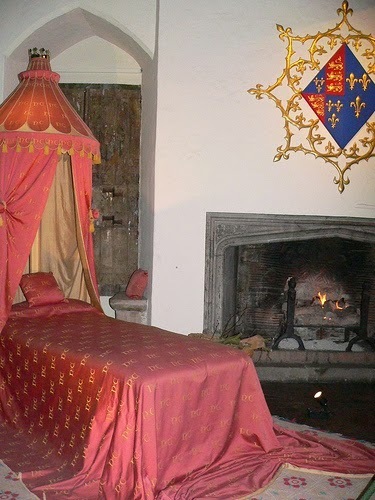
Catherine's BedchamberWhere she met and fell in love with Owen Tudor
Great scandal arose when it was discovered she bore three illegitimate children by Owen, turning the scales of popularity against her for betraying the memory of her late husband, the king. Yet, Catherine’s affair with Owen continued and she bore him two more children.

Catherine's Bath
Slowly scandal emerged. Finally, when she was pregnant with her fifth child by Owen, rumours of a secret marriage between Catherine and Owen emerged. It resulted in Owen Tudor’s imprisonment and Catherine’s banishment to Bermondsey Abbey.
 Bermondsey Abbey
Bermondsey Abbey
Distraught and in shock at the forced separation from her husband and children, Catherine fell gravely ill and died in disgrace. Secretly, before she died, she relayed her wishes regarding the care of her children by Owen to her son. A wooden effigy of Catherine was made for her funeral and survives to this day in the Undercroft Museum at Westminster Abbey.
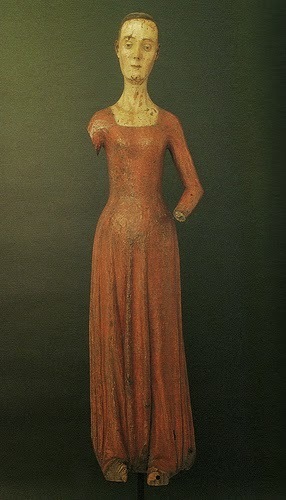
Owen Tudor was arrested soon after her death, but was later acquitted and released. On his return journey to Wales, he was arrested again. He attempted to escape from Newgate Jail in early 1438. Eventually, Henry VI moved him to Windsor Castle and knighted him. He later led the Lancastrian forces at the Battle of Mortimer's Cross for Henry VI against Edward, Earl of March, the Yorkist claimant to the throne. But the Lancastrians suffered defeat and Owen was seized and sentenced to death. Owen, ever hopeful, did not believe he was going to die until the executioner tore the collar off his doublet with the words, “the head which used to lie in Queen Catherine's lap would now lie in the executioner's basket". His head was set on the market cross, where a mad woman combed his hair and washed his face, setting lighted wax torches round about it.
Poor Catherine, even in death, scandals plagued her. Even in death, she could find no peace. Her tomb, made of alabaster, was destroyed during renovations years later when her grandson, Henry VII reigned as king. To distance himself from the scandals of illegitimacy his grandmother forced upon his lineage, the king ordered her memorial to be removed. Something went wrong, however, and the lid of Catherine's coffin accidentally opened. Her corpse was revealed to the world. For generations thereafter, the public came to view her corpse, now a grisly tourist attraction.

Samuel Pepys
In 1669 the diarist Samuel Pepys kissed the long-deceased queen on his birthday and wrote about it in his diary:
“On Shrove Tuesday 1669, I to the Abbey went, and by favour did see the body of Queen Catherine of Valois, and had the upper part of the body in my hands, and I did kiss her mouth, reflecting upon it I did kiss a Queen: and this my birthday and I thirty-six years old and I did kiss a Queen.”
Catherine's remains were not properly re-interred until the reign of Queen Victoria, when in 1878 her body was re-buried in Henry V's chantry.
An excellent novel about the life of Catherine of Valois is The Agincourt Bride by Joanna Hickson.

Back Cover
The epic story of the queen who founded the Tudor dynasty,told through the eyes of her loyal nursemaid.Her beauty fuelled a war.
Her courage captured a king.
Her passion would launch the Tudor dynasty.
When her own first child is tragically still-born, the young Mette is pressed into service as a wet-nurse at the court of the mad king, Charles VI of France. Her young charge is the princess, Catherine de Valois, caught up in the turbulence and chaos of life at court.
Mette and the child forge a bond, one that transcends Mette’s lowly position.
But as Catherine approaches womanhood, her unique position seals her fate as a pawn between two powerful dynasties. Her brother, The Dauphin and the dark and sinister, Duke of Burgundy will both use Catherine to further the cause of France.Catherine is powerless to stop them, but with the French defeat at the Battle of Agincourt, the tables turn and suddenly her currency has never been higher. But can Mette protect Catherine from forces at court who seek to harm her or will her loyalty to Catherine place her in even greater danger?
ReviewbyMirella Patzer
The Bride of Agincourt is a biographical novel about the life of Catherine of Valois and highlights the events of the battles for and surrounding Agincourt, France. The story is told through the first person narrative of Guilliamette, also known as “Mette” who enters Catherine’s life as a wet nurse after the death of her firstborn. Mette becomes enchanted with Catherine and a strong bond that will last their entire lives is born. The novel portrays the journey and struggles each woman faces because of their rank and circumstances, bringing to life the social standards and expectations for women during the early 15thcentury.From the days of her childhood, to her marriage to Henry V, to her love affair with Owen Tudor, Mette tells the secrets of Catherine’s life. She highlights Catherine’s wisdom and intelligence, as well as her beauty and social skills. Of course, there are a few love stories intertwined to keep the reader entertained.
With plenty of intrigue, scandals, and courtly machinations, there is plenty to laud about this finely written tale. Never boring and highly engaging, this is one tale of Catherine de Valois’ life not to miss! Highly recommended.










Catherine of Valois
Catherine was one of eight children born to King Charles VI of France and Isabelle of Bavaria.


Isabelle of Bavaria
Mental illness ran rampant in the family. In fact, her father, the king, suffered from severe schizophrenia. Desperately ill, he was delusional. At times, he believed he was made of glass and breakable, and fearfully fought off anyone who dared come near him. Other times, he ranted and raved that he had no wife and children, running from chamber to chamber in the castle. Sometimes he believed his enemies were upon him and would be thrashing and fighting off the invisible foes. But King Charles was not the only one in the family who was mad. His mother, Joan of Bourbon was unbalanced and became totally deranged after giving birth to her seventh child. Her father, uncles, and grandfather also suffered mental maladies.
Catherine’s mother, Isabelle, was haughty, callous, and openly adulterous to her poor ailing father. She took advantage of the king’s frailties and seized control of the kingdom from usurpers. Isabelle was so busy with politics, poor Catherine and her siblings were neglected. The siblings lived like paupers in miserable surroundings.

King Henry V
Catherine was then married to King Henry V of England who invaded France. They had one child, a son they named Henry VI, but her husband died of dysentery before he could lay eyes upon his heir. When her father King Charles VI died a few months later, Catherine’s young son became king of both England and France.
 Catherine's sonKing Henry VI
Catherine's sonKing Henry VIFearing that Catherine would get married and her new husband might wield too much influence over the infant king, Humphrey Duke of Gloucester, passed a law that forbid Catherine from marrying without the consent of the king and council.

Henry Duke of Gloucester
Despite the law, Catherine fell in love with Owen ap Maredudd ap Tudor, a handsome Welshman of lower rank. He was the keeper of her wardrobe and they soon became lovers.

Catherine's BedchamberWhere she met and fell in love with Owen Tudor
Great scandal arose when it was discovered she bore three illegitimate children by Owen, turning the scales of popularity against her for betraying the memory of her late husband, the king. Yet, Catherine’s affair with Owen continued and she bore him two more children.

Catherine's Bath
Slowly scandal emerged. Finally, when she was pregnant with her fifth child by Owen, rumours of a secret marriage between Catherine and Owen emerged. It resulted in Owen Tudor’s imprisonment and Catherine’s banishment to Bermondsey Abbey.
 Bermondsey Abbey
Bermondsey AbbeyDistraught and in shock at the forced separation from her husband and children, Catherine fell gravely ill and died in disgrace. Secretly, before she died, she relayed her wishes regarding the care of her children by Owen to her son. A wooden effigy of Catherine was made for her funeral and survives to this day in the Undercroft Museum at Westminster Abbey.

Owen Tudor was arrested soon after her death, but was later acquitted and released. On his return journey to Wales, he was arrested again. He attempted to escape from Newgate Jail in early 1438. Eventually, Henry VI moved him to Windsor Castle and knighted him. He later led the Lancastrian forces at the Battle of Mortimer's Cross for Henry VI against Edward, Earl of March, the Yorkist claimant to the throne. But the Lancastrians suffered defeat and Owen was seized and sentenced to death. Owen, ever hopeful, did not believe he was going to die until the executioner tore the collar off his doublet with the words, “the head which used to lie in Queen Catherine's lap would now lie in the executioner's basket". His head was set on the market cross, where a mad woman combed his hair and washed his face, setting lighted wax torches round about it.
Poor Catherine, even in death, scandals plagued her. Even in death, she could find no peace. Her tomb, made of alabaster, was destroyed during renovations years later when her grandson, Henry VII reigned as king. To distance himself from the scandals of illegitimacy his grandmother forced upon his lineage, the king ordered her memorial to be removed. Something went wrong, however, and the lid of Catherine's coffin accidentally opened. Her corpse was revealed to the world. For generations thereafter, the public came to view her corpse, now a grisly tourist attraction.

Samuel Pepys
In 1669 the diarist Samuel Pepys kissed the long-deceased queen on his birthday and wrote about it in his diary:
“On Shrove Tuesday 1669, I to the Abbey went, and by favour did see the body of Queen Catherine of Valois, and had the upper part of the body in my hands, and I did kiss her mouth, reflecting upon it I did kiss a Queen: and this my birthday and I thirty-six years old and I did kiss a Queen.”
Catherine's remains were not properly re-interred until the reign of Queen Victoria, when in 1878 her body was re-buried in Henry V's chantry.
An excellent novel about the life of Catherine of Valois is The Agincourt Bride by Joanna Hickson.

Back Cover
The epic story of the queen who founded the Tudor dynasty,told through the eyes of her loyal nursemaid.Her beauty fuelled a war.
Her courage captured a king.
Her passion would launch the Tudor dynasty.
When her own first child is tragically still-born, the young Mette is pressed into service as a wet-nurse at the court of the mad king, Charles VI of France. Her young charge is the princess, Catherine de Valois, caught up in the turbulence and chaos of life at court.
Mette and the child forge a bond, one that transcends Mette’s lowly position.
But as Catherine approaches womanhood, her unique position seals her fate as a pawn between two powerful dynasties. Her brother, The Dauphin and the dark and sinister, Duke of Burgundy will both use Catherine to further the cause of France.Catherine is powerless to stop them, but with the French defeat at the Battle of Agincourt, the tables turn and suddenly her currency has never been higher. But can Mette protect Catherine from forces at court who seek to harm her or will her loyalty to Catherine place her in even greater danger?
ReviewbyMirella Patzer
The Bride of Agincourt is a biographical novel about the life of Catherine of Valois and highlights the events of the battles for and surrounding Agincourt, France. The story is told through the first person narrative of Guilliamette, also known as “Mette” who enters Catherine’s life as a wet nurse after the death of her firstborn. Mette becomes enchanted with Catherine and a strong bond that will last their entire lives is born. The novel portrays the journey and struggles each woman faces because of their rank and circumstances, bringing to life the social standards and expectations for women during the early 15thcentury.From the days of her childhood, to her marriage to Henry V, to her love affair with Owen Tudor, Mette tells the secrets of Catherine’s life. She highlights Catherine’s wisdom and intelligence, as well as her beauty and social skills. Of course, there are a few love stories intertwined to keep the reader entertained.
With plenty of intrigue, scandals, and courtly machinations, there is plenty to laud about this finely written tale. Never boring and highly engaging, this is one tale of Catherine de Valois’ life not to miss! Highly recommended.









Published on September 16, 2014 11:00
September 13, 2014
Lucrezia and Barbara - the suspicious deaths of the Duchesses of Ferrara

Barbara of Austria
Barbara of Austria was one of the four daughters of Holy Roman Emperor Ferdinand I and Anna of Bohemia. Athough her blood was as blue as it gets, in the beauty department, she was sorely lacking. Rather, she was known for being deeply religious, kind, and empathetic. The daughter of an emperor, regardless of her looks, would be considered quite a catch for any young man of the nobility seeking to raise their social status and power because of her connections to Austria and Spanish royalty. Despite her lack of beauty, numerous proposals were made for her hand in marriage. It was Duke Alfonso II, the Duke of Ferrara who ultimately was permitted to marry her.

Alfonso IIDuke of FerraraBut Barbara was not his first wife. In fact, Alfonso was previously married to the very wealthy and great beauty named Lucrezia Medici. Not long into their marriage, poor Lucrezia became ill. She began to lose weight, developed a horredous cough that would not cease, suffered from fever, and endured constant nose bleeds. The symptoms could not be curtailed and steadily grew worse until she finally died. Although the cause of death was said to be tuberculosis, rumours abounded that she had been poisoned.

Lucrezia Medici
So it was under this shadow, that poor Barbara came to Ferrara to be Alfonso's second wife. By all accounts, they were happy, even though they were not blessed with children. Barabara was a kind and compassionate duchess who used her own money to support young orphan girls after a devastating earthquake. Like her husband’s first wife, at a tender age, Barbara also fell ill with the exact same symptoms as those of her predecessor, Lucrezia. Barbara died at the age of thirty-three. Coincidence? No one can never know for certain. History shall never reveal its secrets.The story of these two fascinating women is immortalized in the story, The Second Duchess by Elizabeth Loupas.
 Back Cover Blurb
Back Cover BlurbA rich, compelling historical novel-and a mystery of royal intrigue.
In a city-state known for magnificence, where love affairs and conspiracies play out amidst brilliant painters, poets and musicians, the powerful and ambitious Alfonso d'Este, duke of Ferrara, takes a new bride. Half of Europe is certain he murdered his first wife, Lucrezia, the luminous child of the Medici. But no one dares accuse him, and no one has proof-least of all his second duchess, the far less beautiful but delightfully clever Barbara of Austria. At first determined to ignore the rumors about her new husband, Barbara embraces the pleasures of the Ferrarese court. Yet wherever she turns she hears whispers of the first duchess's wayward life and mysterious death. Barbara asks questions-a dangerous mistake for a duchess of Ferrara. Suddenly, to save her own life, Barbara has no choice but to risk the duke's terrifying displeasure and discover the truth of Lucrezia's death-or she will share her fate.
Review
by
Mirella Patzer
Renaissance Italy is my favourite genre of historical fiction, and Elizabeth Loupas has written a wonderful story about two of this era's leading ladies. When Barbara of Austria marries Alfonso d'Este, the Duke of Ferrara, she has no idea she will be forced to encounter the ghost of his first wife, Lucrezia, who was said to have been poisoned. For the sake of her marriage, Barbara does her best to ignore the rumours, but she soon finds her husband to be less than what he appears. He is arrogant, coldly assessing, and a man who would be more than capable of murder to suit his own needs. Despite all this, Barbara is determined to unearth the secrets behind a hidden painting of his first wife and how and why she died.
The story is told through the points of view of Barbara and the ghost of Lucrezia - a fascinating tool that I found very powerful when it came to the development of both characters. These two distinct voices highlighted the differences and the similarities between the two minutes. But it was through the malevolent spirit of Lucrezia who revealed the secrets of her marriage.
I loved this story. It engrossed me from the very first page and held my interest until the gripping ending. The author has done an excellent job of bring the royal courts of Renaissance Italy to vibrant life. The characters are ever evolving, always doing the unexpected, and becoming larger than life as more and more secrets are exposed. This is a wonderfully engaging story! One of the best in the genre of Italian historical fiction.









Published on September 13, 2014 10:53
September 12, 2014
Hoyden of the Week - Tattoo obsession
Published on September 12, 2014 17:56
September 5, 2014
Hoyden of the Week - Pot Luck Anyone?
Published on September 05, 2014 16:54
Meet Philippa Gregory and Book Giveaway!
Yup, you heard it! Philippa Gregory is coming to Canada - to Toronto on September 22nd, 2014! For all you fans wishing to attend, Simon and Schuster is sponsoring this fabulous contest and giveaway!
If you live near Toronto and can attend, you can win two tickets to this exciting event. I'm also giving away a copy of the book.
To qualify and enter, please read the following instructions carefully.
1. Leave your full name, email, and Facebook or Twitter username as a comment on this post and be a follower of History and Women or Historical Novel Review Blog on either Twitter or Facebook at:
Twitter - @HistoryandWomen
Facebook - HistoryandWomen
Twitter - @HistoricalNovel
Facebook - HistoricalNovelReview
2. Please specificy whether you are entering to win the tickets or the book.
3. Please ensure you have provided all the above information in the comments so that I can reply should you win! If there is missing information, I may not be able to reach you and will draw again.
The winner will be chosen randomly. I will count up all the entries, number them, and draw one lucky winner.
The draw will be made on September 15th!
Good luck to everyone who enters.
For more info on the book: http://books.simonandschuster.ca/Kings-Curse/Philippa-Gregory/9781451626117
Philippa’s website: www.philippagregory.com
Chapter excerpt: http://issuu.com/touchstonebooks/docs/the_king_s_curse









Published on September 05, 2014 13:26
September 3, 2014
True life Rapunzels! The Sutherland Sisters and their 37 feet of hair!
It has always been said that a woman's crowning glory is in her hair. This has never been more true than for the seven Sutherland sisters who became wealthy because of the incredible length of their hair. Together, their hair measured and incredible 37 feet in length.

From the left: Sarah, Naomi, Fletcher, Grace, Victoria, Dora, Mary, and Isabella
In the 19th century, married or mature women wore their hair up. So when hair was worn unbound and loose, it was considered erotic.

The sisters were born into extreme poverty between the years 1851 and 1865 in Cambria, New York.
As a means of pulling his family out of poverty, their father, Reverend Fletcher Sutherland, tried to get them into theatres as singers. But it wasn't their parlor songs and ballads that gained them fame, it was their hair. The grand finale of their act was when they turned their backs to the audience and their father shouted, "Let down your hair."
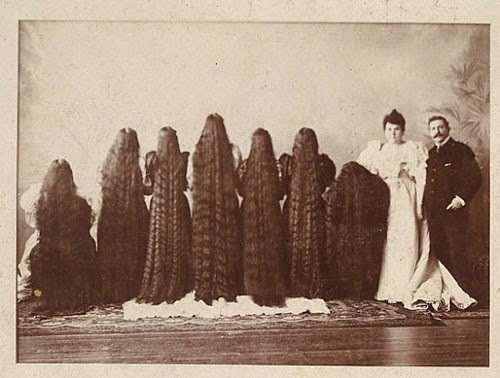
But how did their hair come to grow so long, the public wondered? A rumor circulated stating that their mother had applied some form of concoction to enhance the growth. Whether that was true or not, their father soon created a special tonic made from 56% witch-hazel water, 44% rum, salt, magnesium, and hydrochloric acid, and marketed it. With the seven sisters used a proof the product works, and the fact that their father was a respected preacher, the product was highly successful and the family suddenly found themselves comfortably wealthy. From tonics, the company expanded into numerous other lotions and cosmetics.


Actual bottle
The sisters played to sold out crowds in theatres throughout the United States. They became huge celebrities and millionaires. But mismanagement of their wealth resulted in each of the sisters dying destitute.
 Sara Sutherland1845 - 1919
Sara Sutherland1845 - 1919
Although Sarah's hair wasn't the longest, she was the sister who managed the group's singing and dancing acts in the various theatres. She was the President of their company.

Grace Sutherland1845 - 1946
Grace boasted the longest hair. A beautiful auburn color, it was five feet long and a source of great pride to her. She never married and died a spinster in 1946.
 Dora "Kitty" Sutherland1858 - unknown
Dora "Kitty" Sutherland1858 - unknown
Dora was the Vice-President of the company. She was one of the younger sisters and has an alto voice. Her hair was abundantly thick and about five feet long.

Isabella Sutherland1852 - 1914
Isabella's hair was one of the longest at 6 feet. Of the sisters, she married twice.
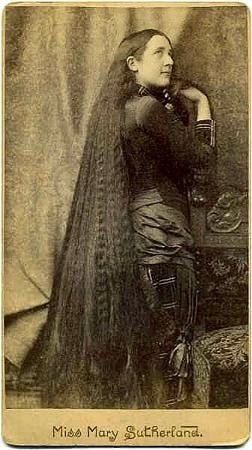
Mary Sutherlandunknown - 1939
Mary's dark brown hair was thick, heavy, and long at 6 feet. Mary suffered from mental problems her entire life.

Naomi Sutherland1858 - 1893
Although Naomi's hair wasn't the longest, it was the thickest and could cover her entire body. She was married to Henry Bailey, the son of Barnum of Barnum and Bailey. It was Henry who officially formed the Sutherland Sister's Corporation and helped create and sell the special hair tonics associated to them.
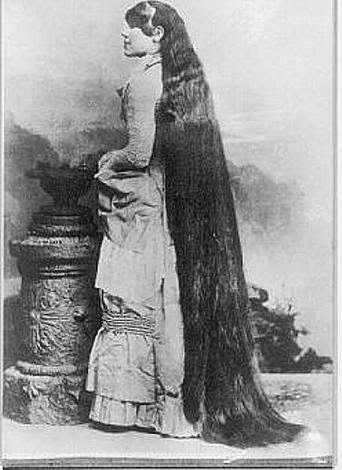
Victoria Sutherland1849 - 1902
Of all the sisters, Victoria was the most beautiful of the sisters and the one with the longest hair at 7 feet. This lovely cougar married a 19 year old when she was 45 years old!
Loosely based on their history is the novel, The True and Splendid History of the Harristown Sisters by Michelle Lovric.

Back Cover Blurb
It’s rural Ireland in the second half of the nineteenth century, the age of the Pre-Raphaelites, when Europe burns with a passion for long, flowing locks. So when seven sisters, born into fatherless poverty, grow up with hair cascading down their backs, to their ankles, and beyond, men are not slow to recognize their potential.
Soon, they’re a singing and dancing septet: Irish jigs kicked out in dusty church halls. But it is not their singing or their dancing that fills the seats: it is the torrents of hair they let loose at the end of each show. In an Ireland still hungry and melancholy with the Great Famine, the Swiney hair is a rich offering. And their hair will take dark-hearted Darcy, bickering twins Berenice and Enda, plain Pertilly, gentle Oona, wild Ida, and fearful, flame-haired Manticory—the writer of their on- and off-stage adventures—out of poverty, through the dance halls of Ireland, to the salons of Dublin and the palazzi of Venice. It will bring them suitors and obsessive admirers, it will bring some of them love and each of them loss. For their past trails behind the sisters like the tresses on their heads and their fame and fortune will come at a terrible price.
Rich in period detail, peopled by a bewitching cast of characters, The True and Splendid History of the Harristown Sisters is a tale of exploitation and celebrity, illegitimacy and sibling rivalry, love triangles and financial skullduggery, of death and devilry. And a very great deal of hair.
Reviewby Mirella Patzer
Told through the eyes of Manticory Swiney, one of the seven Swiney sisters, and the one with the vibrant auburn hair, the reader is swept into Harristown, Kildare, at the height of the great Irish famine. Starving and destitute, the sisters live a desperate hand to mouth existence. Their long hair is plagued with lice, and their bodies are emaciated from hunger. Each of the girls possesses a different hair color, from black, to red, to blonde.
Tired of poverty, the eldest is shrewd and strong-willed enough to place her sisters on a stage and demand they perform. Their claim to fame is not their acting, dancing, and singing, rather, it is their courage to break free from the social restrictions regarding bound hair. At the end of each performance, when the sisters turn their backs and let loose a cascade of hair, the audience roars! Like a feral cat ready to pounce, an antagonist named Eileen O’Reilly does her best to thwart the sisters at every turn.
The novel is richly written and based upon the true life story of the Sutherland sisters in the USA during the 19th century. It is a rags to riches to rags story that I found myself completely absorbed by. Each of the sisters was depicted with plenty of faults and qualities, which added to my interest in this fascinating tale. It is a roller coaster ride that takes the reader to joy, love, despair, and tragedy. This is a wonderful book and I highly recommend it to book clubs as there is an avalanche of material that will lead to many a lively discussion. A lovely book into the odd and unusual lives of these fascinating women.










From the left: Sarah, Naomi, Fletcher, Grace, Victoria, Dora, Mary, and Isabella
In the 19th century, married or mature women wore their hair up. So when hair was worn unbound and loose, it was considered erotic.

The sisters were born into extreme poverty between the years 1851 and 1865 in Cambria, New York.
As a means of pulling his family out of poverty, their father, Reverend Fletcher Sutherland, tried to get them into theatres as singers. But it wasn't their parlor songs and ballads that gained them fame, it was their hair. The grand finale of their act was when they turned their backs to the audience and their father shouted, "Let down your hair."

But how did their hair come to grow so long, the public wondered? A rumor circulated stating that their mother had applied some form of concoction to enhance the growth. Whether that was true or not, their father soon created a special tonic made from 56% witch-hazel water, 44% rum, salt, magnesium, and hydrochloric acid, and marketed it. With the seven sisters used a proof the product works, and the fact that their father was a respected preacher, the product was highly successful and the family suddenly found themselves comfortably wealthy. From tonics, the company expanded into numerous other lotions and cosmetics.


Actual bottle
The sisters played to sold out crowds in theatres throughout the United States. They became huge celebrities and millionaires. But mismanagement of their wealth resulted in each of the sisters dying destitute.
 Sara Sutherland1845 - 1919
Sara Sutherland1845 - 1919Although Sarah's hair wasn't the longest, she was the sister who managed the group's singing and dancing acts in the various theatres. She was the President of their company.

Grace Sutherland1845 - 1946
Grace boasted the longest hair. A beautiful auburn color, it was five feet long and a source of great pride to her. She never married and died a spinster in 1946.
 Dora "Kitty" Sutherland1858 - unknown
Dora "Kitty" Sutherland1858 - unknownDora was the Vice-President of the company. She was one of the younger sisters and has an alto voice. Her hair was abundantly thick and about five feet long.

Isabella Sutherland1852 - 1914
Isabella's hair was one of the longest at 6 feet. Of the sisters, she married twice.

Mary Sutherlandunknown - 1939
Mary's dark brown hair was thick, heavy, and long at 6 feet. Mary suffered from mental problems her entire life.

Naomi Sutherland1858 - 1893
Although Naomi's hair wasn't the longest, it was the thickest and could cover her entire body. She was married to Henry Bailey, the son of Barnum of Barnum and Bailey. It was Henry who officially formed the Sutherland Sister's Corporation and helped create and sell the special hair tonics associated to them.

Victoria Sutherland1849 - 1902
Of all the sisters, Victoria was the most beautiful of the sisters and the one with the longest hair at 7 feet. This lovely cougar married a 19 year old when she was 45 years old!
Loosely based on their history is the novel, The True and Splendid History of the Harristown Sisters by Michelle Lovric.

Back Cover Blurb
It’s rural Ireland in the second half of the nineteenth century, the age of the Pre-Raphaelites, when Europe burns with a passion for long, flowing locks. So when seven sisters, born into fatherless poverty, grow up with hair cascading down their backs, to their ankles, and beyond, men are not slow to recognize their potential.
Soon, they’re a singing and dancing septet: Irish jigs kicked out in dusty church halls. But it is not their singing or their dancing that fills the seats: it is the torrents of hair they let loose at the end of each show. In an Ireland still hungry and melancholy with the Great Famine, the Swiney hair is a rich offering. And their hair will take dark-hearted Darcy, bickering twins Berenice and Enda, plain Pertilly, gentle Oona, wild Ida, and fearful, flame-haired Manticory—the writer of their on- and off-stage adventures—out of poverty, through the dance halls of Ireland, to the salons of Dublin and the palazzi of Venice. It will bring them suitors and obsessive admirers, it will bring some of them love and each of them loss. For their past trails behind the sisters like the tresses on their heads and their fame and fortune will come at a terrible price.
Rich in period detail, peopled by a bewitching cast of characters, The True and Splendid History of the Harristown Sisters is a tale of exploitation and celebrity, illegitimacy and sibling rivalry, love triangles and financial skullduggery, of death and devilry. And a very great deal of hair.
Reviewby Mirella Patzer
Told through the eyes of Manticory Swiney, one of the seven Swiney sisters, and the one with the vibrant auburn hair, the reader is swept into Harristown, Kildare, at the height of the great Irish famine. Starving and destitute, the sisters live a desperate hand to mouth existence. Their long hair is plagued with lice, and their bodies are emaciated from hunger. Each of the girls possesses a different hair color, from black, to red, to blonde.
Tired of poverty, the eldest is shrewd and strong-willed enough to place her sisters on a stage and demand they perform. Their claim to fame is not their acting, dancing, and singing, rather, it is their courage to break free from the social restrictions regarding bound hair. At the end of each performance, when the sisters turn their backs and let loose a cascade of hair, the audience roars! Like a feral cat ready to pounce, an antagonist named Eileen O’Reilly does her best to thwart the sisters at every turn.
The novel is richly written and based upon the true life story of the Sutherland sisters in the USA during the 19th century. It is a rags to riches to rags story that I found myself completely absorbed by. Each of the sisters was depicted with plenty of faults and qualities, which added to my interest in this fascinating tale. It is a roller coaster ride that takes the reader to joy, love, despair, and tragedy. This is a wonderful book and I highly recommend it to book clubs as there is an avalanche of material that will lead to many a lively discussion. A lovely book into the odd and unusual lives of these fascinating women.









Published on September 03, 2014 11:31
August 29, 2014
Hoydens of the Week - Knock-out
Published on August 29, 2014 16:51
August 24, 2014
Sex, Drugs, Satanism, and Violence - The debauched life of Betty May

"I have not cared what the world thought of me and as a result what it thought has often not been very kind... I have often lived only for pleasure and excitement." Betty May
Wild and out of control, singer and dancer, the outrageous flapper, Betty May, climbed out of extreme poverty and rose to the highest levels of society through sex, drugs, and violence.She was born into squalor in Canning Town England in 1895. Her father abandoned the family. Her mother worked at a chocolate factory to support her four children, but her wages were not enough. They had no furniture, not even beds, and slept on bundles of rags. Food was always in short supply. Unable to feed all four children, Betty’s mother had no choice but to send Betty and her brother to live with their father, a shiftless violent drunkard who lived in a brothel with his prostitute girlfriend. When her father was arrested by his own father, a police officer, and later jailed, Betty was shunted off to other relatives, and finally ended up living with an aunt who believed her to be a “savage child” and treated her harshly and raised her rigidly.
Her first sexual encounter was with one of her school teachers. The ensuing scandal was so rampant, it threatened the poor man’s career, so her aunt kicked her out with only a little money in her pocket. Betthy went to London and became a frequent customer at the exotic Café Royal. She liked it and said, “...a real café with sawdust on the floor, cheap drinks and gilded decorations as gaudy and as bright as possible....No duck ever took to water, no man to drink, as I to the Café Royal.” Fond of color and fashion, Betty began to dress outrageously, like a gypsy. Soon, she began to dabble in prostitution to support herself. There she also began a career singing in dancing on various stages.

She met a man named Pretty Pet, a great dancer who was always loaded with cash. He offered her dancing gigs in Bordeaux, but when they got there, he assaulted her in her hotel room while he was drunk. She managed to fight him off by stabbing his neck with a knife and striking him over the head with a pair of metal fire-tongs before fleeing.
Afterward, she encountered the White Panther, a man who belonged to the notorious and extremely brutal, L'Apache Gang and travelled to Paris with him. The gang was a violent one, committing numerous robberies and garrottings, and Betty soon learned to fight with her fists and knives. Her skill with a knife and her knuckles earned her the nickname Tiger Woman.

An Apache Revolver

L'Apache Gang brawl with police in Paris
One of the crimes she committed for the gang was to seduce and an Englishman and lure him to the gang’s lair so they could rob him. The victim reported the crime to the police. Unhappy, the gang threatened Betty – ordering her to find the man again or they would kill her. Somehow, Betty did find the man again. To punish her, the gang ordered her to brand the man with a red-hot knife. “I cannot imagine how I was able to do it, for although I have this violent temper, this was done in cold blood.”
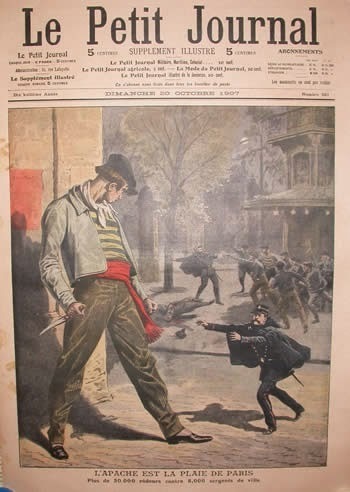
Having had enough of the gang, she returned to London. Her next encounter was with a man named Bunny – a cocaine addict. He introduced the drug to her on their honeymoon. For the next few months, Betty indulged in so many drug binges, she was surprised she survived it. Numerous failed suicide attempts failed to release her from the nightmare she was living. After Bunny died of an overdose, Betty met an Australian military officer called Roy. Roy was a bit heavy handed and beat her harshly whenever he caught her taking drugs. As much as she loathed the beatings, it cured her of her drug addictions. But when she caught him cheating on her, Betty left him.

It was then she met and married her third husband, Raoul Loveday, a poet and secretary to occultist and bisexual Aleister Crowley, known as the “the wickedest man in the world”.
 Aleister Crowley
Aleister CrowleyCrowley convinced Betty and Raoul to go to Sicily where they dabbled in creepy bloody rituals of devil-worship. In fact, Crowley wanted to sacrifice Betty. Instead, she watched her husband behead a cat and drink its blood and die within hours. The death was actually attributed to him having drank water from a polluted stream. Angry at Crowley, she pulled out a gun and shot at him. She missed. He reacted by catching her and then physically throwing her out the door.

Raoul Loveday
Betty returned to London where she married her fourth husband, Carol, an editor for a sports newspaper. She kept his last name a secret and did not include it in her autobiography. They moved to the countryside to live with Carol's mother who was jealous of Betty’s influence over her son, and as a result, they did not get along well with each other. Unhappy with the tensions and the boring country life, Betty left and returned to London. Carol went after her and convinced her to return. Betty agreed and made an effort to develop her own interests by starting her own business, a sweet shop. One day, after shooting rooks, May was disgusted when she had to break the necks of those that fell to the ground alive. The birds were baked into a pie, but still disgusted, Betty refused to eat any of the pies. Soon Carol fell sick with a high temperature and vomiting. Anger between Betty and her mother-in-law arose with mommy blaming Betty. After a few days, a doctor was called and Carol showed signs of improvement. After eating one of the meals Betty prepared for him, Carol’s health regressed again. Carol’s mother accused Betty of killing her son. Betty left her husband and discordant mother-in-law immediately.
What followed for Betty was a string of affairs, more scandals, and a crazed staulker who was on trial for murder and wanted to marry her then kill her. After her autobiography was published by Duckworth in the mid 1930’s, no one knows where she disappeared to. She had not communicated with the publishers for quite some time and they tried to find her. It was reported she was living in a semi-basement bed-sitter in Chatham, and then travelled to northern England for a time before returning to Chatham three years after that. Betty May is believed to have died in Kent in the 1970s or 1980s.Her original autobiography has been re-released to coincide with a musical about her life.

Book Synopsis
The incredible life story that inspired the forthcoming new musical, Tiger Woman Versus The Beast
Dancer, singer, gang member, cocaine addict and sometime confectionist, Betty May’s autobiography Tiger Woman thrilled and appalled the public when her story first appeared at the end of the roaring twenties.
‘I have often lived only for pleasure and excitement but you will see that I came to it by unexpected ways’
Born into abject squalor in London’s Limehouse area, May used her steely-eyed, striking looks and street nous to become an unlikely bohemian celebrity sensation, a fixture at the Café Royal, London, marrying four times along the way alongside numerous affairs.
‘I wondered why men would not leave me alone. They were alright at first when they offered to show one life, and then at once they became a nuisance’
She elbowed her way to the top of London’s social scene in a series of outrageous and dramatic fights, flights, marriages and misadventures that also took her to France, Italy, Canada and the USA.
‘I learnt one thing on my honeymoon – to take drugs’
Her most fateful adversary was occultist and self-proclaimed ‘Great Beast’ Aleister Crowley, who intended her to be a sacrificial victim of his Thelemite cult in Sicily, but it was her husband – Oxford undergraduate Raoul Loveday – who died, after conducting a blood sacrifice ritual.
Betty May’s vitality and ferocious charisma enchanted numerous artistic figures including Jacob Epstein and Jacob Kramer. A heroine like no other, this is her incredible story in her own words, as fresh and extraordinary as the day it was first told.
My Review
When Betty May wrote her autobiography in 1929, her debauched life story shocked society at the time. Now, nearly a century later, the book continues to have the same effect. When I began reading, I was immediately drawn to her narrative, one that was brutally honest and insightful. I could not help but feel sorry for Betty as she described her terrible childhood and the lack of love and attention she was denied by her parents and their circumstances. As the story progressed, I continued to be shocked by the ease into which she fell into a wayward life, partly for the sake of survival and partly for an inner coldness she seemed to possess that helped her survive.
From the first page to the last, I was fascinated by all that she had experienced. From satanism, her numerous husbands and failed marriages, sexual encounters, prostitution, life and death threats, crimes, and drug addiction, it would be an understatement to say she lived a colorful life.
It's not a long book, but Betty May definitely had a talent for writing for her escapades are relayed in a vibrant, shocking manner. I have to say, this is one of the most gripping autobiographies I have ever written. It is no surprise that it has endured for nearly a century. A truly fascinating woman and a tale of survival!









Published on August 24, 2014 14:27























